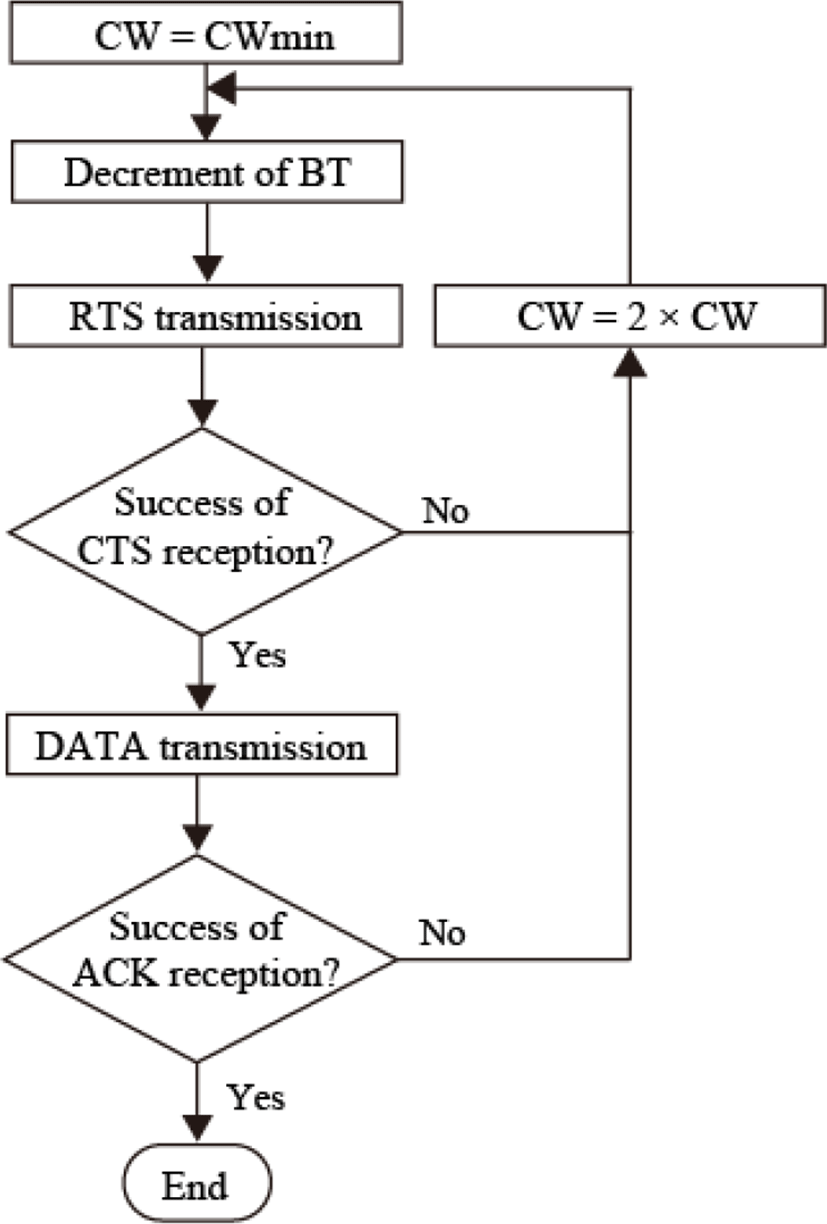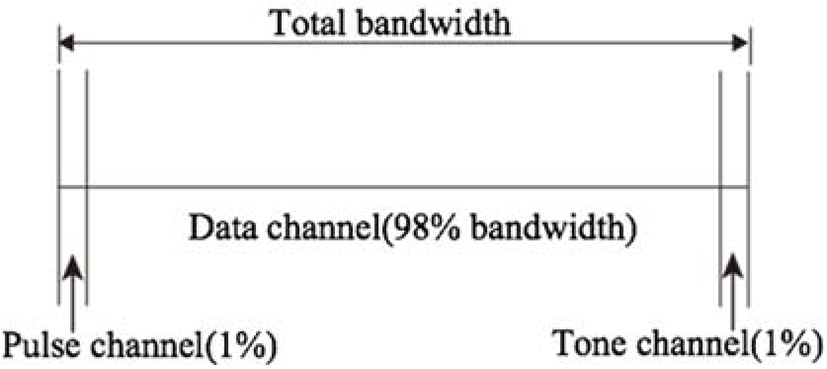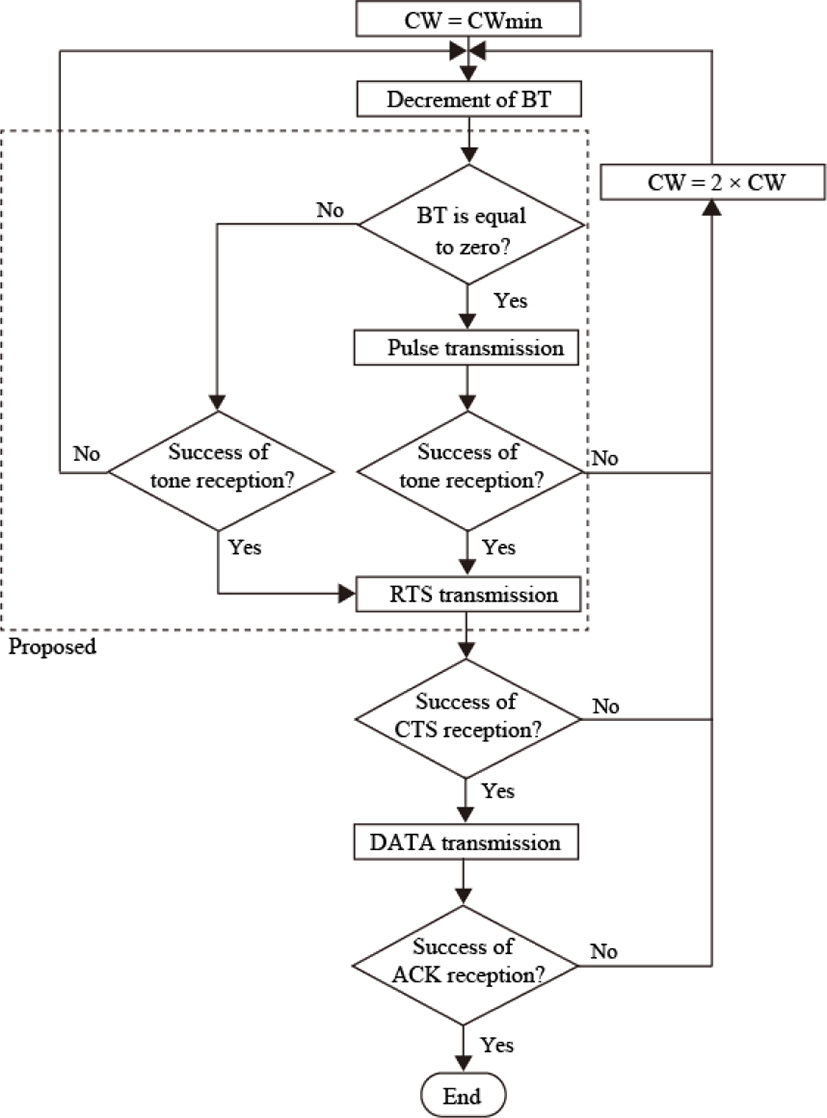I. INTRODUCTION
In wireless networks with Multiple-Input and Multiple-output (MIMO) system, multiple-packet reception technique has attracted as key techniques to achieve a high transmission rate [1-4]. It is possible for a reception node to decode multiple incoming streams simultaneously by applying the multiple-frame reception techniques. In [1-4], Medium Access Control (MAC) protocols of multiple-packet reception were considered. It is necessary that multiple nodes start to transmit a frame with time synchronization for decoding multiple packets. If start times of frame transmissions are not synchronized, it is impossible for the reception node to decode multiple streams correctly. The start time offsets between multiple-frame transmissions among hidden nodes degrade the network performance, which is a problem in multiple-frame receptions. Namely, the transmission synchronization among hidden nodes is important technology for improving the network performance with multiple-frame reception technique. However, there is no research to achieve transmission synchronization among hidden nodes.
On the other hand, MAC protocols applying pulse/tone exchanges were proposed in single-input single-output (SISO) systems [6-8], which improve network performance. Because pulse and tone signals are narrow-band and short-duration signals, no information is embedded on them. Therefore, pulse/tone signals have been used to inform particular network conditions to neighbor nodes. In the previous protocols in [6-8], the pulse/tone signals are used for avoiding frame transmission overlaps, which can mitigate frame collisions induced by hidden nodes.
This paper proposes a novel MAC protocol for achieving transmission synchronization among hidden nodes in MIMO ad-hoc networks. The transmission synchronization can be achieved by applying the pulse/tone exchanges, which are the key idea of this paper. By exchanging pulse/tone signals, transmission nodes, which are in the relationship of hidden nodes, can transmit frames with transmission synchronization. Therefore, multiple-packet receptions among hidden nodes can be achieved. In addition, the frame collisions induced by hidden nodes are reduced, which also enhances network throughput. The effectiveness of the proposed protocol is confirmed from simulation results.
II. PREVIOUS WORKS
In MIMO systems [1-4], each node has multiple antennas. A node can transmit data streams, which are less than or equal to the antenna number. Conversely, a node can decode multiple streams correctly if the total number of incoming streams is less than or equal to its antenna numbers. In addition, when data streams are allocated among interference nodes properly, a receiver can decode multiple data streams, which are transmitted by multiple nodes. Namely, multiple communications among interference links can be established. The multiple communications, however, can be achieved only when the multiple nodes start to transmit frames simultaneously. Therefore, MIMO systems can improve spatial utilization efficiency as well as network throughput, which is required in ad-hoc networks.
In the conventional protocols in [1-4], by carrying out the request-to-send/clear-to-send (RTS/CTS) handshakes, the present resource allocations are comprehended and channel state information (CSI) is obtained. The CSI is used to separate multiple data frames at receiver. The data streams, frequency band, multilevel factor, and transmission powers are allocated to transmitters by using resource-allocation information. Figure 1 shows a flowchart of the conventional MAC protocol for multiple-packet reception presented in [1].
In the conventional protocol in [1], a transmitter starts to transmit an RTS frame when the backoff timer (BT) is zero. The initial value of BT is randomly chosen from between zero and contention window (CW) value. When BTs of multiple nodes are zero simultaneously, the nodes start to transmit an RTS frames simultaneously, which are interfered one another. A node, however, can decode multiple RTS frames if the total number of incoming streams is less than or equal to its antenna numbers because of MIMO technology. Though a receiver has no prior knowledge of the transmitters, it is possible to decode multiple RTS frames by applying a blind detection technique [5]. If a receiver succeeds in receiving the RTS frames, the receiver determined resource allocations of the transmitters based on the data-allocation information included in the RTS frame. The receiver replies a CTS frame, which include allocation results. The transmitters, which receive the CTS frame from receiver, start a data frame transmission by following the allocated resources. When the receiver can receive data frame successfully, the receiver transmits an ACK frame for reception confirmations.
The conventional protocol [1] is, however, assumes that there is no hidden node in networks. Because the all nodes are in the carrier-sensing range one another, multiple nodes always start to transmit a frame simultaneously, namely transmission-start time offset is always zero. When there are nodes in the relationship of hidden nodes in a network, a node can start to transmit a frame, even if a hidden node is transmitting another frame. In this case, the transmission-start-time offsets appear. When there is a transmission-start-time offset, a node cannot decode the multiple frames correctly. Therefore, it is regarded that RTS-frame collisions occur. Figure 2 shows an example of RTS-frame collisions due to offsets of multiple-RTS frame transmissions. In Figure 2, the nodes A and C have a transmission frame to the nodes B and D, respectively. Additionally, it is assumed that the node C is a hidden node of the node A. When the BT of the node A is shorter than that of the node C, the node A starts to transmit an RTS frame when the BT becomes zero. Because the node C is a hidden node of the node A, it cannot sense the node-A transmission state and continues to decrease the BT. As a result, the node C start to transmit an RTS frame during the RTS-frame transmission of the node A. From the node B viewpoint, an offset of multiple-RTS frame transmissions appears as shown in Figure 2. Because of the offset, it is impossible for the node B to decode multiple streams from both the nodes A and C. This means that the offset of multiple-RTS frame transmissions causes RTS frame collisions. In this case, the node A cannot receive a CTS frame and go to retransmission process, which degrades the network throughput.
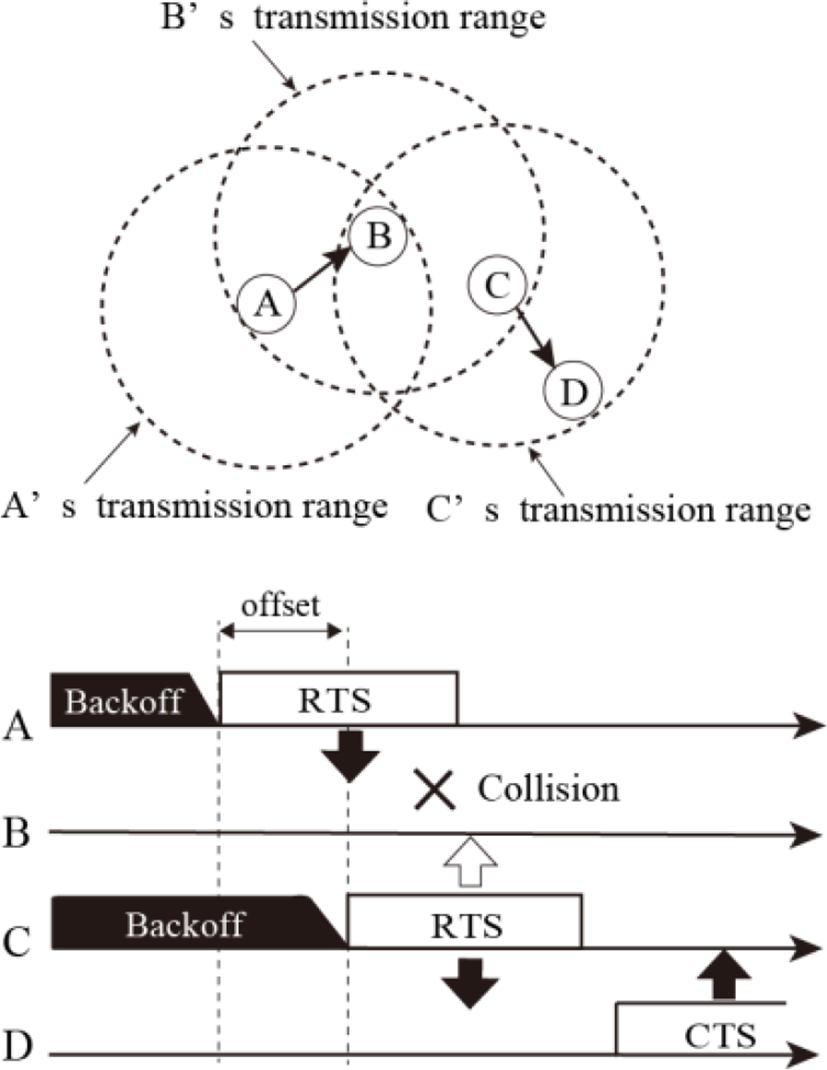
MAC protocols applying pulse and tone exchanges are proposed in SISO systems [6-8]. Because pulse and tone signals are narrow-band and short-duration signals, any information such as transmitter information cannot be embedded on them. According to [6, 9], it is sufficient for nodes to detect the pulse and/or tone signals in 5 μs with 1 % of data frequency bands is given, which is much shorter than the RTS frame length. The pulse and tone can be placed at both the ends of the channel spectrum for ensuring adequate spectral separation between two channels, as shown in Figure 3. Because of the narrow band and short duration, the pulse/tone exchange does not interfere with the other frame transmissions. Additionally, there is no concept of ‘collisions’ among pulses and tones because they include no information on themselves.
Figure 4 shows the pulse/tone exchange process proposed in [6]. In Figure 4, the node A sends a pulse prior to the RTS frame transmission. When neighbor nodes, which are in the range of the transmitter communication range, detect the pulse, they send a tone after the short inter-frame space (SIFS) duration. Nodes, which detect pulse and/or tone, go to the carrier-sensing state. Because both pulse and tone contain no information, all two-hop neighbor nodes of the transmitter defer their transmissions in the pulse/tone protocol. The overlap probability of multiple pulses is much lower than that of RTS frame collisions. As a result, RTS frame collisions induced by hidden nodes are effectively mitigated.
III. OVERVIEW OF THE PROPOSED PROTOCOL
In this paper, a MAC protocol for MIMO ad-hoc networks is proposed. The basic idea of the proposed MAC protocol is that pulse/tone exchanges are applied to the multiple-packet reception MAC protocol in [1]. Figure 5 shows a flowchart of the proposed protocol for transmitters. Compared with Figure 1, which is the flowchart of the conventional protocol of multiple-packet reception in [1], the pulse/tone exchange process is newly added posterior to the BT decrement procedure. A node, which detect tone signal and has a transmission frame, starts to transmit an RTS frame even if the BT is not zero. By exchanging pulse/tone signals, transmitters, which are in the relationship of hidden nodes, can achieve RTS-transmission synchronization. In the proposed protocol, pulse/tone exchanges are used for achieving transmission synchronization among hidden nodes, which is the main idea of this paper. The purpose of the pulse/tone usages is different from that of the conventional protocol with pulse/tone exchange in [6-8]. The reception node can decode multiple transmission data correctly because no offset appears among multiple RTS-frame transmission.
Figure 6 shows an example of transmission synchronization among hidden nodes in the proposed protocol. We consider the same situation as Figure 2. Following the flowchart in Figure 5, the pulse/tone exchanges are carried out after completing the BT decrements as shown in Figure 6. Posterior to the BT decrements, the node A sends a pulse signal. All the nodes, which detect the pulse signal, reply a tone signal. In addition, all the nodes, which detect tone signals, transmit an RTS frame if it has a transmission frame. Because the nodes A and C detects the tone signals from the node B in Figure 6, both the nodes A and C transmit an RTS frame posterior a SIFS period. As a result, the nodes A and C, which are in the relationship of hidden nodes, make RTS-frame synchronization by applying pulse/tone exchanges. The node B can receive synchronized multiple RTS frames and decode them correctly. In addition, the synchronization establishments result in the RTS-frame-collision reductions. Therefore, the proposed protocol enhances network throughputs compared with the conventional MIMO protocol.
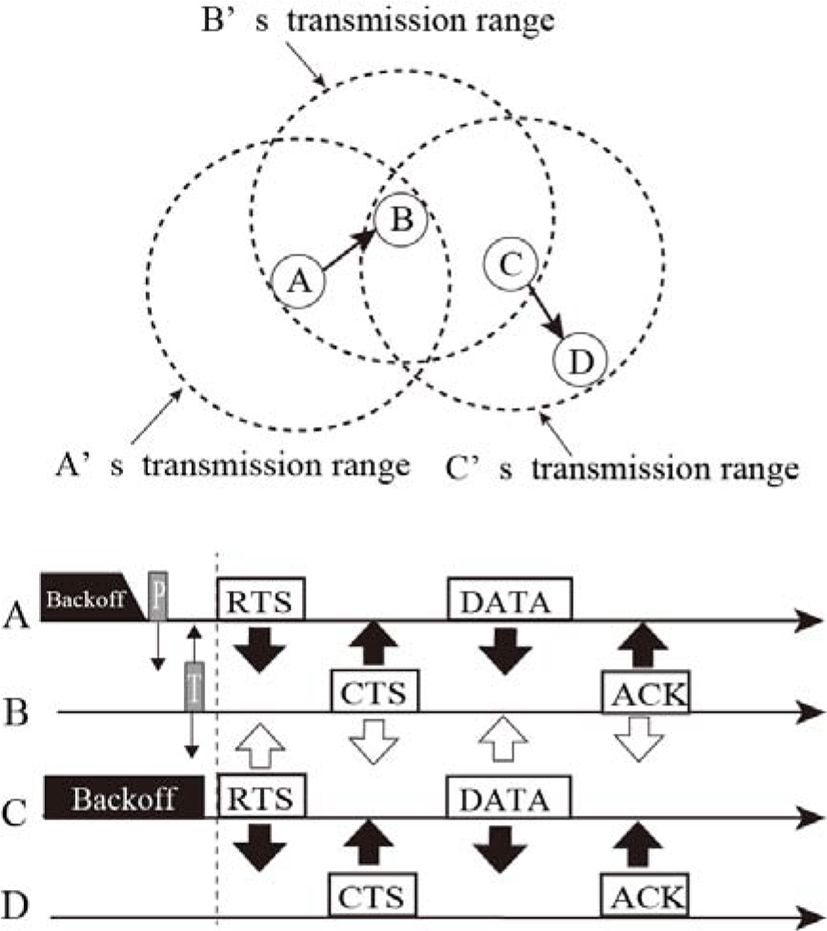
This paper assumes that stream allocations are performed as resource allocation, which follows the technique in [3]. An RTS-frame reception node allocates the data streams fairly for transmitters. It is assumed that each node has N antennas. If the node B receives two RTS frames from the nodes A and C, the node B allocates N/2 data streams to the nodes A and C. Similarly, if the node D receives one RTS frame from the node C, the node D allocates N data streams to the node C. The nodes B and D reply a CTS frame to notify the allocation results to the nodes A and C, respectively. If a node receives multiple CTS frames, the node follows the allocation results on the CTS frame, which has the minimum number of the allocated streams in the all received CTS frames. In Figure 6, the node C follows the allocation results from the node B. According to the allocation information on the CTS frame, the nodes A and C transmit data frame simultaneously. The node B can separate multiple data frames from the nodes A and C with the estimated CSI, which is obtained at the RTS frame reception. Therefore, both the nodes A and C succeed in the frame transmissions to the node B and D, respectively.
In the proposed protocols, the data-transmission time of a node should be the same as those of other nodes. If there are tolerances of data-transmission time among multiple data-frame-transmissions, ACK frames may be collided because of the offset of multiple ACK frame transmissions. In Figure 6, the node C receives the multiple CTS frames and multiple ACK frames from the nodes B and D, which are also decoded correctly because there is no offset between the frame transmissions.
IV. PERFORMANCE EVALUATIONS
This section confirms the effectiveness of the proposed MAC protocol by carrying out simulations. The effects of the layers except the MAC layer are not included in the evaluations in this paper. The proposed MAC protocol is compared with the multiple-packet reception protocol in [1] as a conventional protocol. Table 1 gives the simulation environments in this paper, which basically follow the specifications of IEEE 802.11a standard. 25 nodes, which have four antennas, are placed in the area of 400m × 400m at random. The transmission and carrier-sensing distances of all the nodes are 60 m. The offered load, which expresses as the OL, of a node is identical to those of the other nodes and receiver is selected randomly from nodes in the transmission range. It is assumed that one data frame is transmitted through one stream. The data-frame size is fixed to 1024 bytes. Additionally, the basic transmission rate is 6 Mbps, which is applied to both control and data frames. Both the pulse and tone signals are sent for 5 μs duration.
Figure 7 shows the RTS-frame collision probability as a function of offered load of each node. It is seen from Figure. 7 that the RTS-frame collision probability of the conventional protocol increases as the offered load increases in the range of OL < 3 Mbps. In the conventional protocol, RTS-frame transmission synchronization among hidden nodes cannot be achieved.
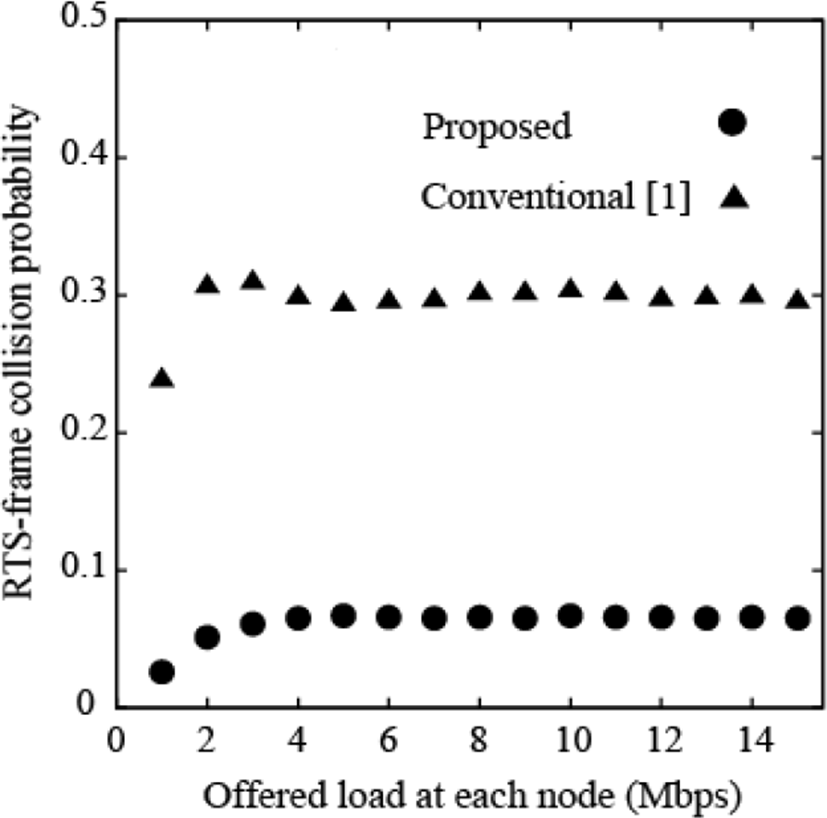
In the range of OL > 3 Mbps, however, the RTS-frame collision probability is independent of the offered load. This is because the transmission probability among hidden nodes is saturated. It is also seen from Figure 7 that the RTS-frame collision probability of the proposed protocol is lower than that of the conventional protocol. In the proposed protocol, the RTS frame collisions caused by offsets among multiple-RTS frame transmissions are reduced by applying pulse/tone exchanges, which are similar characteristics to the SISO-network protocols with pulse/tone signals in [6-8].
Figure 8 shows the average ratio of data-frame-transmission nodes in all the nodes at a certain time as a function of offered load of each node. It is seen from Figure. 8 that the data-frame-transmission node ratio increases with the increase in the offered load in the range of OL < 6 Mbps. In the range of OL < 3 Mbps, the ratio increases because the transmission probability of the network nodes increases. In the range of 3 Mbps < OL < 6 Mbps, network nodes, which has no hidden node, can increase the transmission probability though the nodes, which has hidden nodes, cannot do. Therefore, the ratio of transmission-state nodes increases in the range of OL < 6 Mbps even if the RTS collision probability is saturated at 3 Mbps. It is also seen from Figure 8 the average ratio of data-frame-transmission nodes is constant in the range of OL > 6 Mbps. It can be stated that the transmission-node number in the networks is saturated in this range. It is confirmed from Figure 8 that the ratio of transmission-state nodes of the proposed protocol is higher than that of the conventional protocol. In the proposed protocol, all the nodes, which has data frames and detect tone signals, force the BT to be zero for achieving transmission synchronization. This operation has an effect that the average value of the BT decrement is reduced. Namely, the transmission opportunities of network nodes in the proposed protocol increase compared with the conventional protocol.
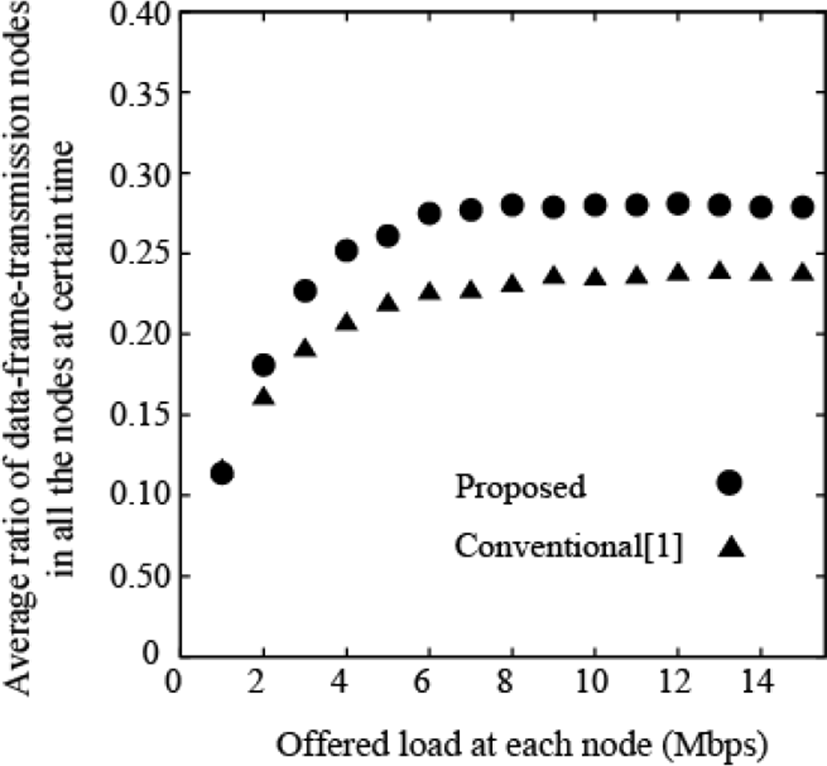
Figure 9 shows the average number of transmitted data frames in the whole network at a certain time as a function of offered load. It is seen from Fig. 9 that the number of transmission data frames increases even when offered load is larger than 6 Mbps though the number of transmission nodes is constant in the range of OL > 6 Mbps as shown in Figure 8. In the proposed MIMO systems, it is possible for a node to transmit multiple data frames. Namely, network nodes transmit multiple data frames with multiple streams, which increase the number of transmitted data-frames. It is also seen from Figure 9 that the number of transmission data frames is constant in the range of OL > 10 Mbps. This is because the network nodes make full use of the available stream numbers, which are limited by antenna number. It is confirmed from Figure 9 that the number of transmission data frames of the proposed protocol is larger than that of the conventional protocol. This is because the proposed protocol achieves transmission synchronization.
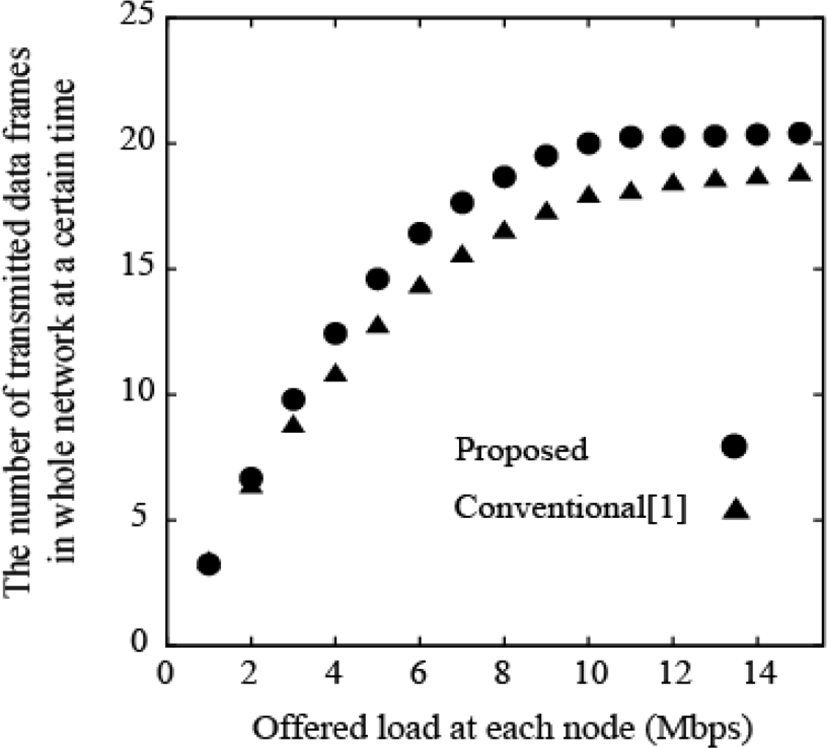
Figure 10 shows the average throughput per node as a function of offered load of each node. It is seen form Fig. 10 that the throughput increases in the range of OL < 10 Mbps. It is confirmed from Figure 10 that the throughput of the proposed protocol is higher than that of the conventional protocol. The proposed protocol reduces RTS-frame collisions as shown in Figure 7. In addition, the number of transmission data frames of the proposed protocol increases by achieving transmission synchronization as shown in Figure 8. From these effects, the proposed protocol can improve the network throughput compared with the conventional protocol.
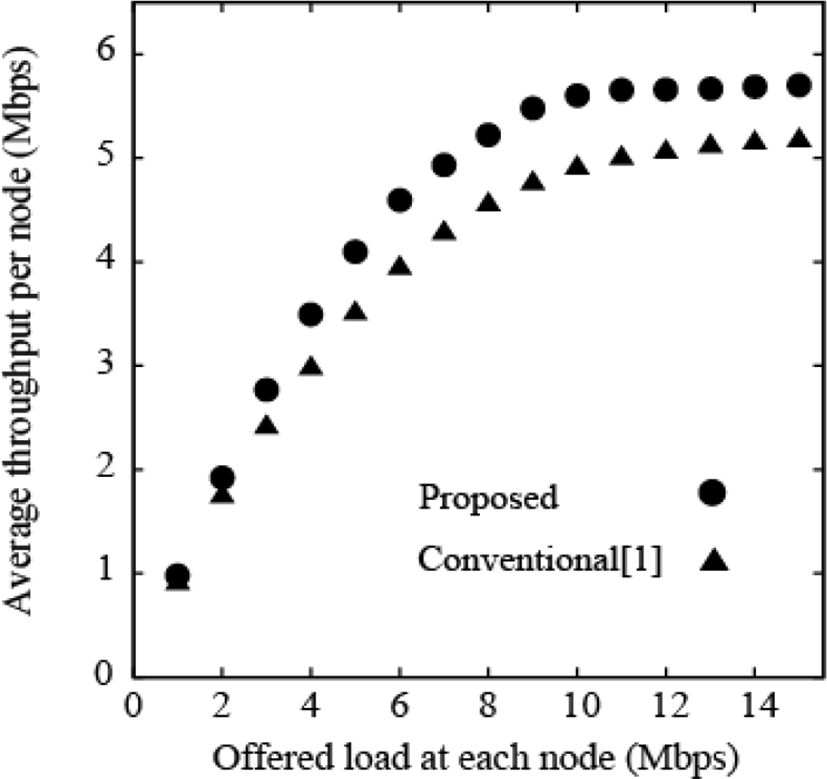
V. CONCLUSION
This paper has proposed the novel MAC protocol for achieving transmission synchronization among hidden nodes in MIMO ad-hoc networks. Transmission synchronization among not only the carrier-sensing nodes but also hidden nodes can be achieved by applying the pulse/tone exchanges, which is a key idea of this paper. By exchanging pulse/tone signals, multiple nodes, which are in the relationship of hidden nodes, can transmit frames with transmission synchronization. In addition, the frame collisions induced by transmission offsets among hidden nodes can be reduced. From these effects, the network throughput can be enhanced in the proposed protocol. The simulation results show the effectiveness of the proposed protocol.
